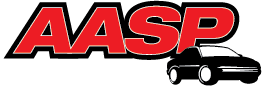3.1.21 – To educate members on the importance of proper ADAS repair, the Alliance of Automotive Service Providers of New Jersey (AASP/NJ) recently welcomed John Anello (Auto Tech on Wheels) and Nick Dominato (adasThink) for “ADAS: The Future Is NOW,” a two-hour Zoom seminar that provided insight into this technology, its requirements and how it will affect the industry moving forward.
As Anello explained, ADAS did not come along overnight. Electric steering came about in the ’90s, and Lane Keeping Assist has been around since 2004. However, over the past few years, ADAS has grown at an overwhelming rate. He reminded collision repairers that if they do not keep up with technology, it will pass them by.
“You have to embrace the technology as it comes to your front door. If you don’t, customers will go to dealerships, and you will start losing your customer base.”
To demonstrate what is involved in some ADAS procedures, he walked repairers through the removal of a bumper with advanced sensors.
“When you are working on these cars, you have to put [sensors] back the way you found them.”
Putting a sensor back in the wrong spot will immediately result in a communication error, and each sensor has to be calibrated. In the case of parking sensors, the angle has to be checked on each one.
Additionally, post-repair scans won’t show underlying issues. Anello explained a situation where lights came on while test driving a repaired vehicle. Upon noticing a substantially misaligned radar, he took off the cover to discover it pointing down to the ground.
“It wasn’t looking for cars anymore; it must have been looking for squirrels.”
The space required to calibrate these radar sensors is another important factor. The perfect shop should have an area that is 40 feet wide by 30 feet deep to do this properly. With more advancements such as automatic emergency braking coming down the pike, knowing how to correctly address these sensors is critically important.
Many repairers may be unaware of how many calibrations are needed on ADAS-equipped vehicles. Dominato explained each manufacturer is different, with some having broader requirements than others.
“We are at about 40-50 percent of most makes having at least one calibration on there.”
Although there are resources that assist repairers, not all are 100 percent reliable. Dominato reminded all that a clear scan report is not a “get out of jail free card.”
“You can do a calibration with a scan tool, but it’s not the ‘all clear.’”
With autonomous driving on the horizon, he cautioned that calibration requirements will only continue.
“ADAS isn’t something up and coming that is going to hit us in two years; it’s been here. We are at 40 percent of things in need of calibration, and it’s being missed 80 percent of the time. That is where we are right now as an industry.”
Of course, performing accurate work in regard to ADAS will protect repair facilities as much as consumers.
“The cars today are outpacing us all, and we have to be able to stay up with it. Liability will fall back into your lap,” commented AASP/NJ President Jerry McNee.
“If this work is not done on these cars, someone is going to die,” echoed AASP/NJ Executive Director Charles Bryant.
For more information on AASP/NJ, please visit aaspnj.org.
